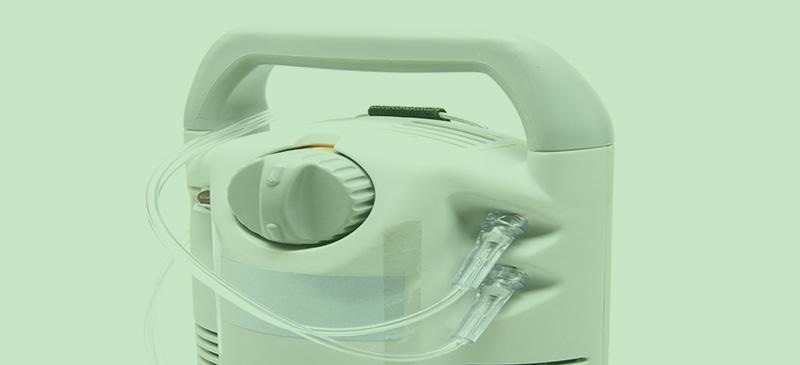One of the reasons for the increasing demand for quality healthcare is the aging population of the world. The number of individuals over 60 years of age is expected to increase from 962 million in 2017 to over 2 billion by the year 2050. As a consequence, the manufacturing and use of many medical products and devices are on the rise.

These trends require more advanced yet smaller medical equipment with lighter weight and reliable parts, which must address possible issues that could come from constant use. At the same time, they need to provide an enhanced quality of life for the patient. An example of such durable medical equipment is the portable oxygen concentrator (POC).
POCs are compact, lightweight systems that provide an alternative to stationary oxygen concentrators. They are a practical alternative, because some POCs weigh less than two pounds in comparison to the stationary equipment that could often weigh up to 40 pounds.
POCs can deliver oxygen therapy to patients who are literally on the move; therefore, their production is becoming one of the fastest growing spheres on the home oxygen supply market.
Another advantage of POCs is that they have been approved for air travel by the FAA (Federal Aviation Administration). POCs can also improve the quality of life of patients with chronic or acute respiratory diseases, such as pulmonary hypertension and fibrosis. They can also provide relief to children with congenital heart diseases, cystic fibrosis or severe cases of asthma.
Concentrating on Helping People to Breathe and Move More Easily
According to Global Market Insights the market for all medical oxygen concentrators is expected to grow to $ 2 billion by the year 2023. Another prediction made by Research and Markets is that much of the market will be occupied by the Global Portable Oxygen Concentrator, growing with 1.56% CAGR - from $ 996 million in 2017, and is expected to reach $ 1, 721 million by 2022.
The highest market share until 2022 will continue to be held by the U.S.A., given the increase in COPD, the aging population and the increased use of driving productions. Nevertheless, Research and Markets also predicts that between 2017 and 2022 the need for POCs will also increase in Europe, as the number of incidences of smoking and respiratory diseases increases.
A growth in the preference for home medical treatments is also expected in the Asia-Pacific area, where the aging of the population also increases; the process in China is being labeled as “graying in China.” It is predicted that about 22 % of the population will be over the age of 60 by the year 2027; another study suggests that 100 million adults may have COPD in China; another factor is the increased pollution as a result of industrialization.
The Crucial Role of Seals and Polymer Parts in Oxygen Concentrator Systems
Oxygen concentrators, also known as oxygen generators, come in two versions – stationary, which are for home use, and portable units, which are mobile. What makes oxygen concentrators different from other oxygen delivering systems, and also unique, is the compressing element.
The above is done by an air compressor, which functions along with other parts, such as a cylinder, flow meter, valve and tubes. The compressor in POCs compresses ambient air, which is then filtered in a concentrator. This is then sent into one of the two sieve bed filters that take turns in removing nitrogen from the air.
This process ultimately results in providing pure oxygen to the patient. One of the main benefits of the stationary unit is that it is a more stable source for oxygen, which can be useful for home use for patients who are not very mobile, or during sleep.
Seals play a critical role in the compressors as they ensure the functionality of the oxygen system. There are two ways in which they need to operate – first, as a bearing to enhance the movement of the piston up and down the cylinder wall, and secondly, as a seal to prevent air from seeping from the chamber while it is being compressed by the piston movement. Cup seals are often used in the application because of their ability to handle very high pressures. These function similarly to lip seals.
Rulon® polymer cup seals by Omniseal Solutions are particularly useful as they are used in many medical device applications. In China these seals are more often applied to stationary units due to cost and need, along with medical coverage and government regulations. The rate of people suffering from asthma, however, is increasing due to air pollution, which results in growth of home oxygen therapy.
By 2023 this market is expected to reach a value of $ 2.5 billion with Chinese vendors pushing to enter worldwide markets. In other regions, such as North America, the cup seals are more often used in POC systems because patients usually prefer a portable medical device that offers convenience and allows them a more active way of life.
The Rulon® PTFE material is a perfect fit for application in portable concentrators. It is a versatile material that is homogenous and can, thus, offer high-performance. It can also provide long wear life, low friction and withstand harsh conditions such as dry running, exposure to aggressive chemicals, and abrasion. It can also operate in extreme temperatures and pressure ranges.
There are many ways in which the Rulon® material can be custom designed into bearings, piston rings, cup seals and other critical parts. Due to its extremely low friction, low heat, low noise, long wear life and low maintenance, the Rulon® product has been successfully used in piston cup seals for years in both stationary and portable oxygen concentrators.
Rulon® J material, offers one of the lowest levels of coefficient friction in reinforced PTFE materials and is frequently used in the start and stop applications of automobiles, along with Rulon® 1189 and Rulon® 1694 grades which are frequently used in POCs.
Benefits of Rulon® Cup Seals in This Application
- Increased durability and reliability due to the material’s long life - an estimated wear life of 20,000 hours and low friction/heat which can function in temperatures from -40 ºF to 212 ºF (-40 ºC to 100 ºC).
- A strong seal which can withstand pressures of 29 psi/two bar and speeds of 0.5 meters per second
- Decreased total costs resulting from the post-sale cost savings on training, technical support, installation, and maintenance
- Versatile customized designs allowing the manufacturers to create even smaller and lighter concentrators due to Omniseal Solutions ability to formulate materials to address specific needs, designs, and exact shapes.
- Dry running with seals in oxygen concentrator systems needing to run dry with less oil and be chemically inert
With over 100 standard Fluoroloy® and Rulon® grades available, many of which are FDA compliant and USP Class VI certified, these materials are not only well-suited for medical devices, but are also a good fit for other analytical equipment.
Omniseal Solutions Rulon® compounds and Omniseal® spring-energized seals have also been used in orthopedic and laparoscopic power tools, harmonic scalpels, chemical analyzers, as well as other critical life sciences applications, such as the following:
- Ultra-High Performance Liquid Chromatography (UHPLC) and High Performance Liquid Chromatography (HPLC) systems: parts are regularly exposed to chemicals in separating, identifying and quantifying compounds, Rulon® polymer bearings help to maximize equipment run time and Omniseal® and Fluoroloy® G piston pump seals ensure high-seal pressure (ranging between 18,000 psi and 1,240 bar), wear resistance, quality and consistency.
- Portable insulin delivery – Rulon® and Meldin® materials are used in the creation of parts to effectively seal the wearable pumps and protect them against moisture to consistently deliver precise doses of insulin. The components can also run dry, are chemically inert and support low friction and long life, necessary for these units.
- In-vitro diagnostic medical devices (IVDs): Omniseal Solutions design team in Japan worked closely with manufacturers to ensure the reliability of this equipment. It conveys blood tests and other tests on samples to monitor health and assess medical conditions for patient care. Today’s IVD systems need to run faster and longer than before, and low-friction materials make sure these requirements are met.
- Surgical tools – OmniSeal® and Rulon® parts are used in creating the parts in these precise fit solutions, enabling smaller, more accurate surgeries. The parts offer low friction and longer life in motor, actuator and linear guide applications.
With over 22 FDA Compliant or USP Class VI materials, Rulon® and other materials from Omniseal Solutions are often used in bearings in the pharmaceutical and food industries for their ability to support strict sanitation requirements. The Rulon® 641 grade is an example of a PTFE filed material that is FDA compliant with USP Class VI approval for direct contact with human tissue and fluids.

This information has been sourced, reviewed and adapted from materials provided by Omniseal Solutions.
For more information on this source, please visit Omniseal Solutions.